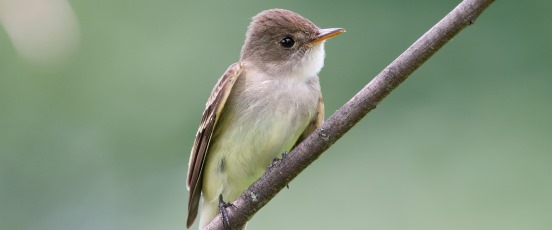
WILLOW FLYCATCHER CONSERVATION

Once considered common throughout much of the Sierra Nevada, the Willow Flycatcher (Empidonax trailii) has declined precipitously since the middle of the twentieth century. By the late 1990s the region’s population was estimated at just 300-400 individuals. Willow Flycatchers appear to have stopped breeding at many historically occupied meadows south of Lake Tahoe and 6% annual declines in population size are reported for the area between the south fork of the Feather River and Lake Tahoe. Recent studies suggest one explanation of the decline is poor nesting success, largely due to meadow desiccation, which allows mammalian predators easier access to Willow Flycatcher nests.
Causes of meadow desiccation throughout the Sierra Nevada include streambank erosion due to livestock grazing and road construction, water diversions, environmental change, and other factors. Yet, many of these factors would appear to play little if any role within the confines of Yosemite National Park, where IBP research has documented that the species has stopped breeding in recent decades.
IBP’s work on Willow Flycatcher in the Sierra Nevada is focused on understanding causes of the population decline, assessing the current status of the species throughout the region, and identifying and facilitating opportunities for restoration and conservation.
For more information about IBP’s work with Willow Flycatchers, please contact Helen Loffland.

IBP’s Willow Flycatcher monitoring crew confers before surveying a Sierra meadow.
Photo Credits: Top left, Kelly Colgan Azar; bottom left, IBP; Right panel, Chandler Dolan.
RECENT RESEARCH
Automated playback of Willow Flycatcher calls encourages re-colonization of restored meadows.
Even as many Sierra meadows have been restored in recent years, Willow Flycatchers are not often settling in them, even when nearby meadows are occupied by the species. One hypothesis to explain the lack of recolonization involves "conspecific attraction." Many birds use songs or calls as cues that other members of their species are around, perhaps signaling the suitability of habitat.

In the summers of 2016 and 2017, IBP researchers, along with colleagues from the California Department of Fish and Wildlife and Tarleton State University, used playbacks of Willow Flycatcher calls to see if they could lure prospecting flycatchers to settle in high-quality unoccupied meadows. Their study was published in the journal Avian Ecology and Conservation in 2018.
The researchers found that unoccupied meadows where Willow Flycatcher vocalizations were played were seven times more likely to be recolonized by flycatchers than meadows where no calls were broadcast. These results strongly suggest that playback of Willow Flycatcher calls could benefit efforts to reestablish the species in restored habitat, though the researchers cautioned that this technique should only be used when the unoccupied habitat has been careful assessed and found to be high-quality.
SELECTED PUBLICATIONS
Peer-reviewed Publications
Schofield, L.N., S.M. Peterson, H.L. Loffland, and K.H. Strohm. 2024. Willow Flycatcher use of irrigation-fed wetlands in the foothills of the Sierra Nevada of California. Western Wildlife 11:19–27. PDF
Schofield, L.N., R.B. Siegel, and H.L. Loffland. 2023. Modeling climate-driven range shifts in populations of two bird species limited by habitat independent of climate. Ecosphere 2023;14:e4408. PDF
Loffland, H.L., L.N. Schofield, R.B. Siegel, and B. Christman. 2022. Sierra Nevada Willow Flycatcher decline continues but losses abate at two restored meadows. Western Birds 53:52-69. PDF
Pyle, P., and B. H. Carnes. 2022. Molt strategies by age and subspecies in the Willow Flycatcher. Western Birds 53:216-231. PDF
Ruegg, K., R.A. Bay, E.C. Anderson, J.F. Saracco, R.J. Harrigan, M. Whitfield, E.H. Paxton, and T.B. Smith. 2018. Ecological genomics predicts climate vulnerability in an endangered southwestern songbird. Ecology Letters 21:1085-1096. For a copy of this publication, please contact Jim Saracco.
Schofield, L.N., H.L. Loffland, R.B. Siegel, C. Stermer, and H.A. Mathewson. 2018. Using conspecific broadcast for Willow Flycatcher restoration. Avian Conservation and Ecology 13:23. PDF
Mathewson, H.A., M.L. Morrison, H.L. Loffland, and P.F. Brussard. 2012. Ecology of willow flycatchers (Empidonax traillii) in the Sierra Nevada, California: effects of meadow characteristics and weather on demographics. Ornithological Monographs 75:1-31. PDF
Siegel, R.B., R.L. Wilkerson, and D.F. DeSante. 2008. Extirpation of the Willow Flycatcher from Yosemite National Park. Western Birds 39:8-21. PDF
Bombay, H.L., M.L. Morrison, and L.S. Hall. 2003. Scale perspectives in habitat selection and animal performance for Willow Flycatchers (Empidonax traillii) in the central Sierra Nevada, California. Studies in Avian Biology 26:60-72. PDF
Other Publications and Reports
Strohm, K.H., and H.L. Loffland. 2015. 2015 Willow Flycatcher Surveys in the Tahoe National Forest. The Institute for Bird Populations, Point Reyes Station, CA. PDF
Loffland, H L., and R.B. Siegel. 2014. 2014 Willow Flycatcher surveys in east-side meadows on the Tahoe National Forest. The Institute for Bird Populations, Point Reyes Station, CA. PDF
Loffland, H.L., R.B. Siegel, C. Stermer, B.R. Campos, R.D. Burnett, and T. Mark. 2014. Assessing Willow Flycatcher population size and distribution to inform meadow restoration in the Sierra Nevada and Southern Cascades. The Institute for Bird Populations, Point Reyes Station, CA. PDF
Siegel, R.B., R.L. Wilkerson, and D.F. DeSante. 2007. Determining the status and distribution of Willow Flycatcher in Yosemite National Park. Report to Yosemite National Park. The Institute for Bird Populations, Point Reyes Station, CA.
Bombay, H.L., T.M. Benson, B.E. Valentine, and R.A. Stefani. 2003. A willow flycatcher survey protocol for California. U.S.D.A. Forest Service. PDF








